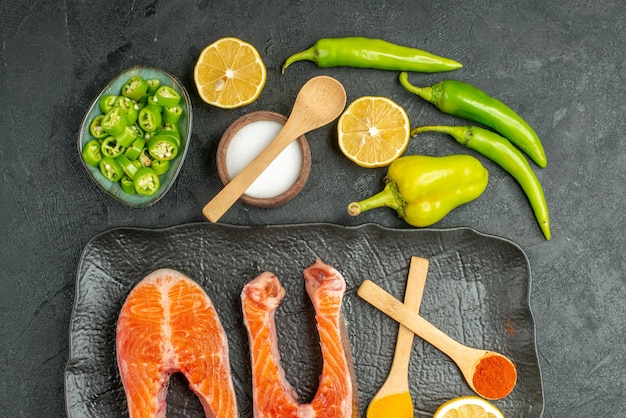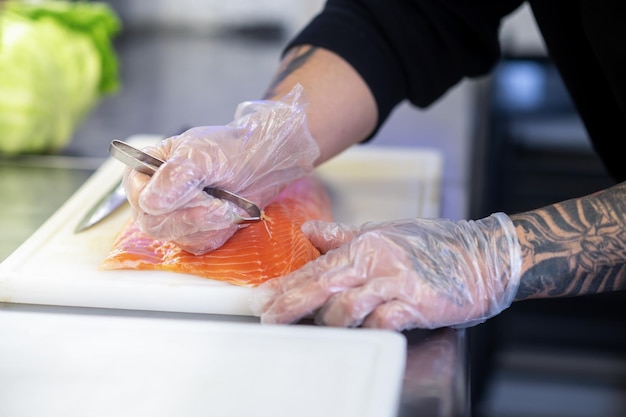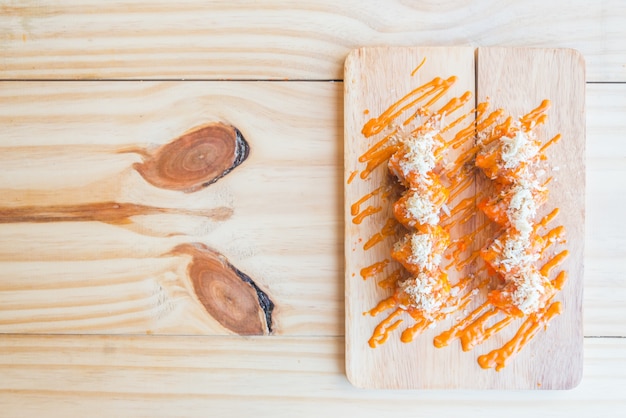Let’s face it – sometimes, life gets busy. You’re craving a delicious salmon dinner, but a trip to the fishmonger just isn’t in the cards. That’s where frozen salmon comes in. It’s a culinary hero, always ready to rescue your dinner plans. But I’m not going to lie – frozen salmon can be tricky. One wrong move and you’re left with a dry, bland mess. But fear not, my fellow foodies! I’m here to share my tried-and-true secrets for unlocking the full potential of frozen salmon. Prepare yourself to turn those frozen blocks into mouthwatering meals!
Part 1: A Look Inside the Freezer

Before we even think about cooking, let’s get familiar with the different types of frozen salmon you might encounter. It’s like knowing your ingredients before you start baking – crucial for success!
Frozen salmon types: A Quick Guide
First up, there’s frozen whole salmon. It’s usually a large rectangular block, sometimes with the skin still on. This is perfect if you’re feeling ambitious and want to roast the salmon whole or portion it yourself. Then there are frozen salmon fillets, pre-portioned slices that are ideal for grilling, pan-frying, or baking. And finally, you might find frozen salmon steaks, which are thicker and more robust than fillets, making them excellent for grilling or baking. They’re practically designed for that satisfying char!
Spotting the Good Stuff
Now, no matter which type you choose, keep an eye out for a few key things when selecting your frozen salmon. First, check the packaging. Make sure it’s sealed tight, no tears or punctures – we don’t want any unwanted surprises. The salmon itself should be evenly coloured, a lovely shade of pink, with no discolouration or ice crystals. A great sign is if the salmon is frozen on a tray with a protective layer of ice. This means it’s been flash-frozen, which helps preserve the quality and flavour. And always, always check the use-by date! Make sure it’s not about to expire, and remember to store it properly in your freezer until you’re ready to cook.
Part 2: Defrosting Secrets

You’ve got your frozen salmon, but now it’s time to defrost it. This might sound like a simple step, but there’s a right way and a wrong way. The wrong way can lead to a soggy, flavourless disaster, so let’s get it right.
Safe Defrosting Methods: Choosing Your Path
Here are the three main methods for defrosting frozen salmon:
- Refrigerator Defrosting: This is the gold standard, the safest and most recommended method. Simply place your frozen salmon in the refrigerator and let it defrost for 6-8 hours, or overnight if you have larger portions. This slow, gentle defrosting ensures that the salmon retains its moisture and texture – no soggy surprises here!
- Cold Water Defrosting: This is a slightly faster method, but it requires a bit more attention. Place the salmon in a sealed plastic bag and submerge it in a bowl of cold water. Change the water every 30 minutes to keep it cold and ensure the salmon defrosts evenly. This method typically takes 30-60 minutes depending on the size of the salmon.
- Microwave Defrosting: While this is the fastest method, it’s not recommended for salmon. Microwave defrosting can cook the salmon unevenly, resulting in a mushy texture and loss of flavour. It’s just not worth the risk, trust me!
Defrosting Don’ts: Avoiding the Mistakes
I know it’s tempting to defrost salmon at room temperature, but don’t do it! This can create a breeding ground for bacteria and make the salmon unsafe to eat. It’s always better to play it safe and choose a safe defrosting method that prevents the salmon from sitting at room temperature for too long.
Part 3: Cooking with Confidence

Alright, now that your salmon is thawed, it’s time to get cooking! This is where the real fun begins. Let’s explore the best ways to turn frozen salmon into a culinary masterpiece.
Preparation is Key: Setting the Stage for Success
Before you start cooking, take a few minutes to prep your salmon. It’s all about setting the stage for a perfect outcome:
- Pat it Dry: After defrosting, thoroughly pat the salmon dry with paper towels. This removes excess moisture and prevents it from steaming while cooking.
- Season to Taste: Season your salmon liberally with salt and pepper. This is the foundation, the base of flavour that brings out the natural sweetness of the salmon. You can also use other seasonings like garlic powder, paprika, or lemon zest. If you’re using a dry rub, apply it just before cooking, so the flavour really gets a chance to sink in.
- Preheat Your Oven or Pan: A hot oven or pan is essential for achieving a crispy skin and evenly cooked salmon. It’s like giving your salmon a little warmth before the big performance.
Cooking Methods: Choosing Your Adventure
There are endless ways to cook frozen salmon, so choose the method that suits your taste and time constraints. Each method offers a unique flavour and texture, so feel free to experiment!
1. Pan-Frying: Quick and Delicious
Pan-frying is a quick and easy way to cook salmon. Simply heat some oil or butter in a pan over medium-high heat. Place the salmon skin-side down in the pan and cook for 3-4 minutes per side, or until it’s cooked through. This method creates a beautiful crispy skin and a juicy, tender inside.
2. Baking: Effortless and Flavorful
Baking is a great option for a fuss-free meal. Preheat your oven to 400°F (200°C). Place the salmon on a baking sheet lined with parchment paper and bake for 12-15 minutes, or until the salmon is cooked through. You can even add a drizzle of lemon juice or some herbs for extra flavour.
3. Grilling: The Smoky Delight
Grilling salmon imparts a smoky flavour and beautiful grill marks. Preheat your grill to medium-high heat. Place the salmon on the grill and cook for 4-5 minutes per side, or until it’s cooked through. The grill marks add a visual appeal and a hint of smoky goodness that elevates the flavour.
4. Roasting: Impress Your Guests
Roasting a whole salmon is a fantastic way to impress your guests. Preheat your oven to 375°F (190°C). Place the salmon on a baking sheet and roast for 20-25 minutes, or until the salmon is cooked through. The salmon will be moist and flaky, and it looks truly spectacular on a platter.
Part 4: The Golden Rule: Don’t Overcook!
This is the key to salmon success, my friends. overcooked salmon is a culinary crime. We want it to be cooked through, but still juicy and tender, practically melting in your mouth.
Signs of Overcooked Salmon: Recognizing the Culprit
Overcooked salmon will be dry, tough, and flaky. The colour will be pale and it might have a greyish hue. The texture will be firm and rubbery, not the delicate flakes you crave.
How to Avoid Overcooking: Preventing Salmon Tragedy
Here are some tips to ensure your salmon stays perfectly moist and delicious:
- Don’t Overcrowd the Pan: If you’re pan-frying or baking salmon, don’t overcrowd the pan or baking sheet. This will prevent the salmon from cooking evenly.
- Use a Thermometer: Invest in a meat thermometer. The internal temperature of cooked salmon should be 145°F (63°C). This ensures the salmon is safe to eat and cooked to perfection.
- Rest the Salmon: Once the salmon is cooked, allow it to rest for a few minutes before serving. This allows the juices to redistribute and the salmon to retain its moisture.
Part 5: Flavour Fusion: Taking Salmon to New Heights
Frozen salmon is incredibly versatile and lends itself beautifully to a wide range of flavour profiles. Here are a few ideas to get your creative juices flowing and turn your frozen salmon into a culinary adventure:
Mediterranean Salmon: A Taste of the Sun
This recipe combines the fresh, bright flavours of the Mediterranean.
- Season your salmon with lemon zest, garlic powder, oregano, and salt and pepper. This creates a wonderful aroma and a burst of flavour that transports you to a sunny Mediterranean coast.
- Drizzle with olive oil and bake or pan-fry until cooked through. The olive oil adds richness and depth to the flavour.
- Serve with a side of roasted vegetables and a drizzle of lemon juice. This creates a complete and satisfying meal, bursting with Mediterranean goodness.
Asian-Inspired salmon: A Flavorful Fusion
For a flavour explosion, try this Asian-inspired salmon recipe.
- Combine soy sauce, sesame oil, ginger, garlic, and chili flakes. This creates a complex and aromatic marinade that infuses the salmon with incredible flavour.
- Marinate the salmon in the mixture for 30 minutes. This allows the flavours to penetrate the salmon, creating a deeper and more complex taste.
- Bake or pan-fry until cooked through. The salmon will be tender and juicy, with a beautiful glaze that adds shine and flavour.
- Serve with a side of steamed rice and stir-fried vegetables. This creates a well-balanced and flavorful meal, drawing on the best of Asian cuisine.
smoked salmon: A Classic Delight
Smoked salmon is a classic for a reason. Here’s how to create a delicious smoked salmon dip:
- Combine cream cheese, smoked salmon, chopped red onion, capers, and dill. This creates a creamy and flavourful dip that’s perfect for parties or a quick snack.
- Mix well and spread on crackers or toasted bread. It’s a crowd-pleaser that’s both elegant and satisfying.
Part 6: Salmon and Sides: The Perfect Pairing
What’s a great salmon dish without the perfect side? Here are a few ideas to complete your meal, ensuring a well-balanced and satisfying culinary experience.
Classic Sides: The Tried and True
Classic sides for salmon include:
- Roasted vegetables: Asparagus, broccoli, carrots, and Brussels sprouts. The roasted vegetables add a touch of sweetness and a contrasting texture to the salmon.
- potato salad: A creamy and comforting side. The potato salad provides a creamy, comforting element that balances the richness of the salmon.
- rice pilaf: A simple and flavorful rice dish. The rice pilaf adds a light and fluffy element to the meal, providing a neutral base for the salmon’s flavours to shine.
Creative Sides: Adding a Touch of Adventure
If you’re feeling adventurous, try these creative sides:
- quinoa salad with feta cheese and herbs. The quinoa salad adds a healthy and vibrant element to the meal, while the feta cheese and herbs provide a salty and tangy contrast to the salmon.
- roasted sweet potatoes with a drizzle of honey. The roasted sweet potatoes add a touch of sweetness and a unique texture to the meal.
- butternut squash risotto with sage. The butternut squash risotto adds a creamy and comforting element to the meal, while the sage provides a subtle earthy flavour.
Part 7: Leftovers Love: Storing and Reheating with Care
Let’s be honest, salmon is so good you might have leftovers. But don’t worry, there’s no need to waste this deliciousness. Here’s how to store and reheat them properly, ensuring they stay safe and tasty.
Storing Leftovers: Preventing Spoilage
To prevent foodborne illness, refrigerate cooked salmon within two hours of cooking. Place the salmon in an airtight container or wrap it tightly in plastic wrap. This helps preserve the salmon’s freshness and prevent it from absorbing other odours in the refrigerator.
Reheating Leftovers: Bringing Back the Flavour
Reheat leftover salmon in a preheated oven or microwave. Make sure it’s heated through before serving. You can also reheat leftover salmon in a pan with a bit of butter or oil, which helps to keep it moist and flavorful.
Part 8: Frequently Asked Questions: Unlocking the Mysteries
Here are some frequently asked questions about frozen salmon, helping you tackle any lingering doubts or queries:
1. Can I freeze thawed salmon again?
It’s not recommended to freeze thawed salmon again. It can affect the texture and flavour of the salmon, making it dry and less appealing.
2. How long can I keep frozen salmon in the freezer?
Frozen salmon can be stored in the freezer for up to 3-6 months for optimal quality. Make sure you store it properly to ensure its freshness and flavour.
3. What are the nutritional benefits of salmon?
Salmon is a great source of protein, omega-3 fatty acids, vitamin D, and potassium. It’s a healthy and delicious addition to any diet.
4. How can I tell if frozen salmon is still good?
If the salmon has a strong fishy smell or has discoloured, it’s best to discard it. Frozen salmon should be free of ice crystals and have a consistent pink colour. Trust your senses – if something seems off, it’s best to err on the side of caution.
5. Can I use frozen salmon for sushi?
While frozen salmon can be used for sushi, it’s important to ensure it’s been properly frozen and thawed. It’s best to consult with a sushi chef or restaurant for guidance, as they have expertise in handling raw fish and ensuring its safety.
Final Thoughts: Embrace the Power of Frozen Salmon
Frozen salmon is an absolute gem in the world of cooking. It’s versatile, affordable, and a great source of nutrients. By following these tips and tricks, you can unlock the full potential of frozen salmon and enjoy delicious and satisfying meals. Remember, don’t be afraid to experiment with different flavours and cooking methods. With a little creativity, you can transform frozen salmon into culinary masterpieces. So, go forth and conquer the world of frozen salmon – you’ll be glad you did!
Everyone is watching

Corn on the Cob: The Ultimate Guide to Perfectly Cooked Ears
Healthy MealsAh, corn on the cob. Just the name evokes images of sunny days, barbecues, and that sweet, juicy flavour that ...

Perfect Pork Roast Oven Cooking Time: A Guide to Delicious Results
Healthy MealsThere's something truly satisfying about a perfectly roasted pork. The aroma alone is enough to make your mout...

Ham Cooking Time: How Long to Bake, Smoke, or Boil a Delicious Ham
Healthy MealsAh, ham. It's a classic, isn't it? A real crowd-pleaser, especially around holidays. And when done right, it'...

Scallops: The Ultimate Guide to Perfect Cooking
Healthy MealsAh, scallops. Those delicate, sweet, and utterly delicious morsels of the sea. They hold a special place in my...

Spaghetti Squash: The Ultimate Guide to Cooking and Serving
Healthy MealsRemember that time you saw spaghetti squash at the supermarket, looking all bumpy and strange, and thought, "W...
